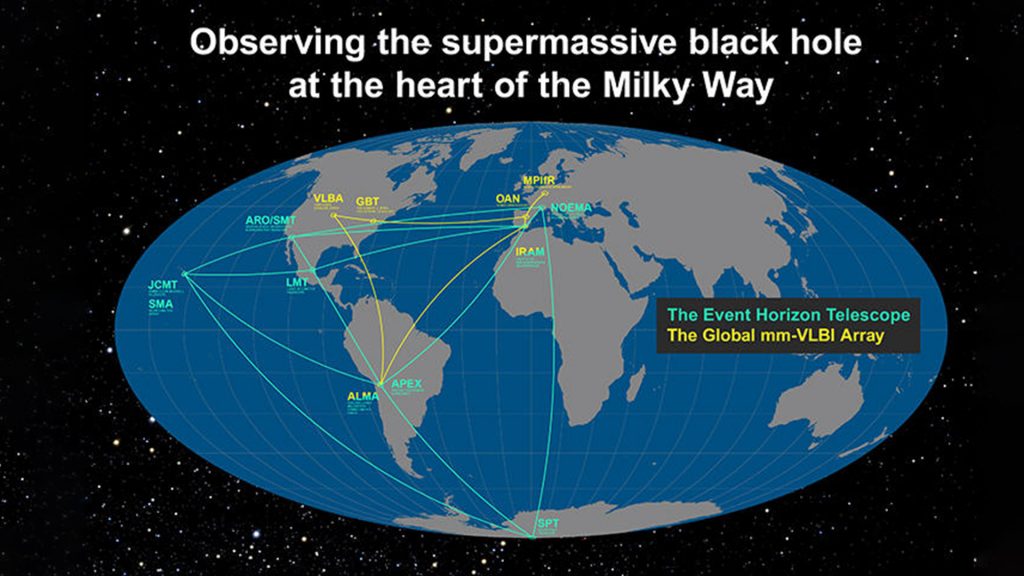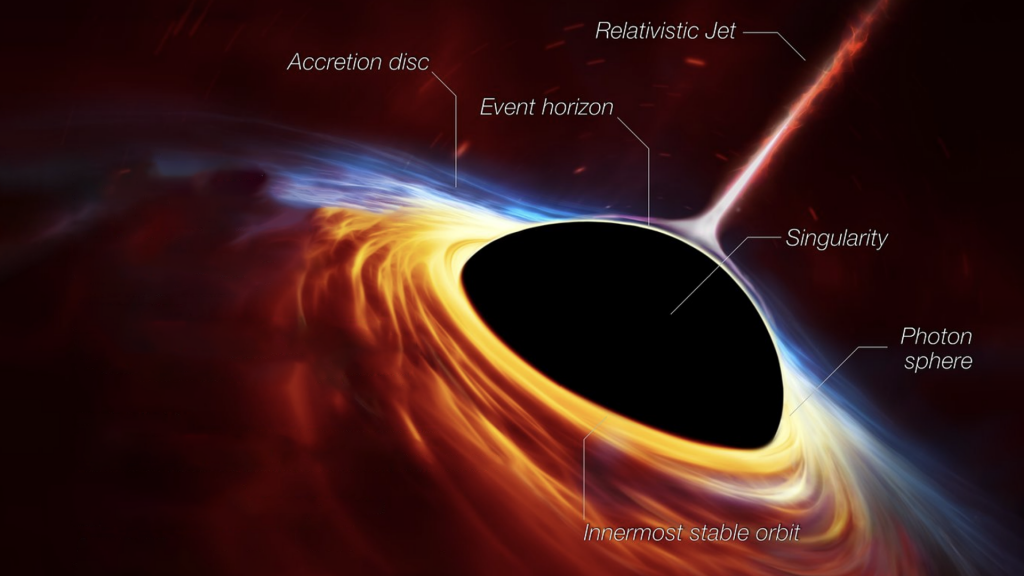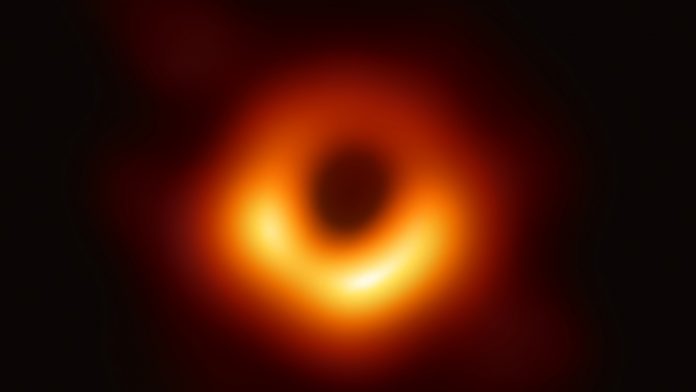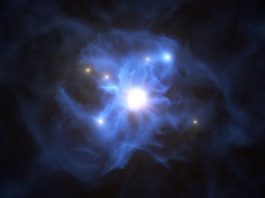Professor Heino Falcke, Radboud University, Nijmegen, spoke to Innovation News Network about the first ever photograph of a black hole – which is situated in the M87 galaxy – the challenges involved in obtaining it, as well as other issues such as the use of outer space.
IN April 2019, a team of astronomers released the first ever image of a black hole. The team used the Event Horizon Telescope (EHT), a network of eight linked telescopes located around the world to take the image of the black hole at the centre of the M87 galaxy, some 500 million trillion kilometres away. The result was a photograph of a bright ring around the black hole, caused by the superheated gas surrounding it. This was the first ever image of lensed and relativistic beamed emission on the scale of the event horizon in extreme gravity, and it helps to constrain models for jet formation and energy extraction from black holes.
Innovation News Network spoke to Radboud University’s Professor Heino Falcke, who first launched the idea of the EHT, and who became chair of its science council, about this and other images, and how they might help to unravel a better understanding of these mysterious cosmic regions. He also discusses the use of space and the need for regulations, as well as Galileo navigation and formations of satellites.
What were the biggest challenges involved in capturing the first ever image of a black hole?
It took 25 years to go from the first idea to the actual realisation. During this time, I remained convinced it was possible, but sometimes you just need to have patience. You also need to convince the rest of the community, and that took some time. And, of course, you need to be in a position to obtain major funding.
The breakthrough for us was the granting of a European Research Council (ERC) synergy proposal, which essentially allowed us to develop from having a good idea but no money to realise it, to being in a leading position and so actually begin to work together to achieve our goals.
Another significant challenge was to agree on and build a global collaboration, which now encompasses 13 major institutions around the world. That was almost as challenging as bringing together the different funding streams.
Were you responsible for building that network?
It was a common effort. An important push for the network was also being made by our US colleagues, and at some point it was not even clear that we would actually be a part of it or join forces. But European infrastructure and significant European money enabled us to participate on the same footing and, of course, we are now co-leading those efforts.
As with any such endeavour, some people are keener than others, and I was certainly one of those people, but in the end you have to work together and we will all cross the finishing line at the same time.
Can you tell me a little about the concept of a ‘black hole shadow’ and how you approached imaging it?
The black hole in the centre of a galaxy called M87 has a mass 6.5 billion times that of the Sun. It is larger than the size of our entire Solar System and it is also one of the heaviest black holes that we think exists. We believed that it would, so to speak, be surrounded by a cloud of light at a certain radio frequency, which we should be able to see with a radio telescope. Of course, you cannot see a black hole directly, but it is thus possible to see it indirectly; you can see its ‘shadow’.
Within our calculations, which we first made for the centre for our own Galaxy, we found that no matter what we did we always saw a dark patch on the sky. That dark patch always had the same size and was a clear characteristic and prediction of what we should be seeing. We therefore called it a ‘shadow’ because it is not the black hole itself, but the deficiency of light it creates.
The term ‘shadow’ is an apt one. A ‘normal’ shadow can hide some of the characteristics of an object, and the same is true of a black hole’s shadow: black holes can be rotating or non-rotating, for example, and the shadow makes it difficult to see. Black holes hide behind their shadows.

The Event Horizon Telescope Collaboration recently imaged the heart of the nearby radio galaxy Centaurus A in unprecedented detail. What do you hope will come from this? What does the image tell us about how jets are launched from the central region of a black hole and how they can extend over scales that are larger than their host galaxies without dispersing out?
This particular black hole is closer than the one that we imaged in the centre of the M87 galaxy but it is also much smaller. Its size meant that it was not possible for us to resolve its shadow, but we are still looking at a region that is very close to the black hole and we can see that these black holes not only swallow matter, they also expel matter in gigantic plasma jets.
Usually, we don’t have the resolution to resolve these jets but we are able to see them here and from that we can see that the emission comes from the edge of those plasma streams. That is, these streams appear to be hollow, which is the same thing we had seen from our imaging of the M87 black hole.
For a trend to emerge in astrophysics, two makes a class, as they say, and from our simulations we now believe that we understand the structure of these gigantic plasma flows which are responsible for a lot of the high energy gamma ray and X-ray emissions from quasars, and which also impact on the gas that surrounds a galaxy, and even entire galaxy clusters, and they can even inhibit the formation of new stars.
These jets are ubiquitous and I think we are fairly close to understanding how they are formed, which has been a significant mystery for the last 50 years or so. That has been achieved through a combination of simulations, extremely detailed computer simulations, and the high resolution image we have now obtained, which, while it may not represent all the details, does show many of the basic properties, thereby demonstrating that we are on the right track.
I think that also gives us hope that we can really do astrophysics at the edge of a black hole. Indeed, I am convinced that at some point we will be able to understand black holes in much more detail and will be able to model them, just like we can model our Sun today, or like we can model our climate or our weather.
A significant amount of data was obtained from the South Pole Telescope, with the total data totalling some 0.5 petabytes. How much of a hurdle is the Big Data challenge? Are there lessons you have learned from elsewhere? Or that you can teach to others (such as the SKA)?
For the South Pole Telescope, one of the main challenges concerned how to get that data from the telescope to the point where it is all collected. No internet connection in the world could do that in real time and definitely not from such a remote place, and so we physically transported the data on hard drives.
Regarding the amount of data in total, sometimes you just have to wait. Indeed, recording all the data was one of the main challenges, and to achieve that we had to wait for the technology; we had to wait for hard drives to become big enough and recording to become fast enough. Even then, it still required custom made hard- and software which can now be obtained almost off the shelf.
Of course, the more data you record the more sensitive you are because you record more light and so have more signal, so generating more data is always going to be important. And to cope with that, you need the technology. However, it is also important not to be afraid when designing a project as ambitious as ours. Of course, such challenges should be taken into account, but that should be done on the premise that the challenges will be solved in time, perhaps even by the time that the project is realised; you need to be forward-looking. And the same is true in regard to everything else, too.

What’s next for the ETH and your own research? What role will space-based telescopes play?
I am thinking of a moderate expansion of the ground-based Event Horizon Telescope. We definitely need telescopes in Africa and I think Europe is very well positioned with its connections and good relations with Africa. We hope that, working alongside our American colleagues, the first will be constructed in Namibia, which would be the first of this kind in all of Africa.
We would also like to see the array expanded through the addition of more telescopes and there is an element of friendly competition to expand the array in different phases. For me, I believe that a few telescopes on the ground will be enough to do what we need to do, and so the next really big step will need to be in space.
The technology to enable telescopes to be placed in a precise location in space and to operate at higher frequencies is all legacy technology, it just hasn’t been put together yet. Space-based telescopes will need to be very precisely localised, and the Galileo navigation satellites will have a role to play here; rather than them being used to navigate on the ground, we will use them in space to build networks of telescopes that are larger than Earth.
What role will space agencies play in helping that to be realised?
We submitted a first proposal to the European Space Agency’s Cosmic Voyage 2050 and they included it in their white paper. It will need to be further developed and examined by ESA, but it will probably be realised as a global collaboration, or at least with one other major international partner in the end. Indeed, there is significant interest in China and the US, just as there is in Europe.
Would you say that the appetite is there on the part of the agencies, then?
Definitely. Programmatically, we need to establish networks of satellites that operate together, and these fleets need to be precisely localised. There is certainly a community that really wants to start using the Galileo satellites at the extreme; we want to know whether it is possible to use Galileo for science in space and for formation flight, and so on.
In the end, we want to establish fleets of spacecraft, and they will not only be used to look into space but also for looking at the ground. Of course, that is something that is happening more and more. However, it is also something that urgently requires regulation because, at the extreme end, we are seeing things like Starlink and other constellations that will be littering space with tens of thousands of satellites.
In the past, space was seen as being unlimited; recently, we have discovered it is not. Space debris is a huge problem and is coming to mean that certain orbits can no longer be used risk-free. Of course, the satellites used in constellations such as Starlink are cheap, and so they can risk losing one or two as a result of a collision. Our satellites are expensive and we cannot afford to lose any.
There is also the issue of the loss of cultural heritage which needs to be discussed. In Namibia, for instance, the night sky is beautiful. Now, however, it is being spoiled by the thousands of satellites being launched by such companies. Yet, the country has no jurisdiction about what is happening to one of its most precious natural wonders.
Is it likely for any kind of global consensus to be reached on restricting what could be termed the privatisation of space?
It must happen; there is no way around it. At the moment, companies are taking advantage of the (hopefully) short period of no regulation to claim as much as they can while they are able to do so and before people wake up. In Europe and other areas of the world, we tend to wake up to these technology transformations often too late, but this is happening right now and countries need to preserve their interests.
Global regulation is not uncommon; it exists for radio frequencies and has for over a century. We now need the same principal to be applied to our skies.
Professor Heino Falcke
Radboud University
h.falcke@astro.ru.nl
www.heinofalcke.org
www.ru.nl/english/people/falcke-h/
https://twitter.com/hfalcke?ref_src=twsrc%5Egoogle%7Ctwcamp%5Eserp%7Ctwgr%5Eauthor
Please note, this article will also appear in the eighth edition of our quarterly publication.









